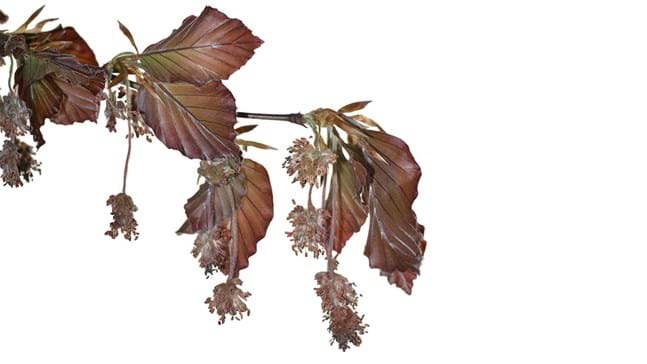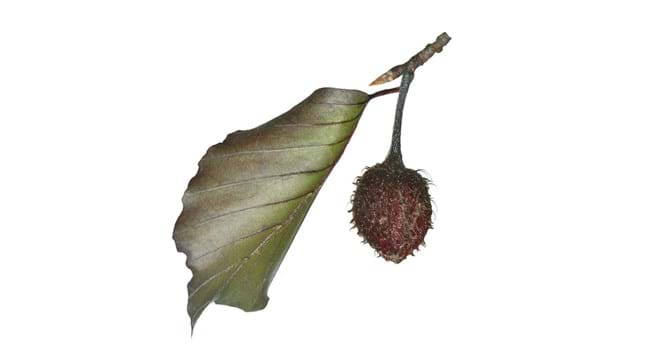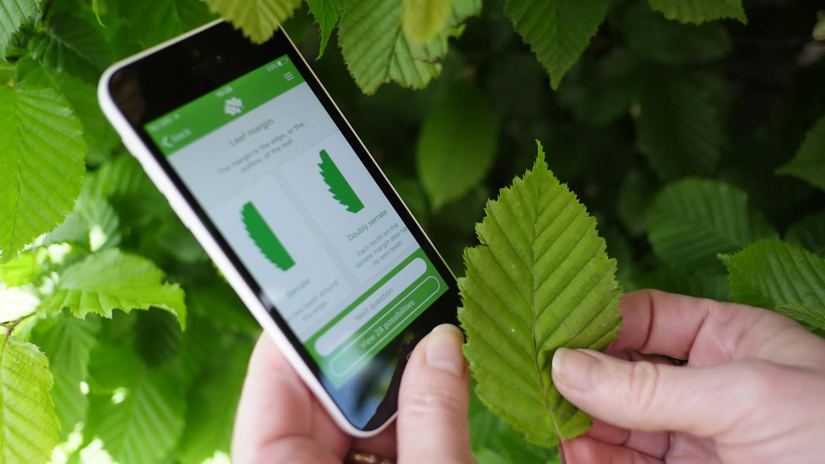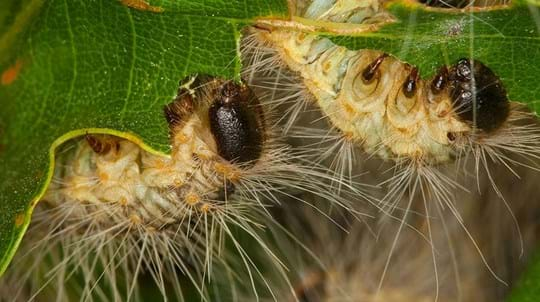
Credit: Nature Photographers Ltd / WTML
Leaves
Deep purple in the spring, turning to a coppery hue in the autumn, oval and fringed with silky brown hairs.
Deep purple, distinctive, dramatic. Loved by some but loathed by others. You’ll often find this striking tree planted in landscape-scale gardens as a specimen tree.
Common name: copper beech
Scientific name: Fagus sylvatica f. purpurea
Family: Fagaceae
Origin: non-native (ornamental cultivar)
Copper beech, also known as purple beech, is a cultivated form of common beech (although copper-coloured beech trees are also sometimes found in nature). It grows to a height of more than 40m. The bark is smooth, thin and grey, often with slight horizontal etchings. Twigs are slender and grey but not straight – their shape resembles a zig-zag. Torpedo-shaped leaf buds are coppery and up to 2cm in length, with a distinctive criss-cross pattern.
Look out for: the red to purple leaves which mark a clear difference in comparison to common beech.
Identified in winter by: its sharply pointed buds, a feature it shares with common beech.

Credit: Nature Photographers Ltd / WTML
Deep purple in the spring, turning to a coppery hue in the autumn, oval and fringed with silky brown hairs.

Credit: Nature Photographers Ltd / Alamy Stock Photo
Monoecious, meaning both male and female flowers grow on the same tree. In April and May the copper beech’s tassel-like male catkins hang from long stalks at the end of twigs, while female flowers grow in pairs, surrounded by a cup.

Credit: Nature Photographers Ltd / WTML
Once wind-pollinated, this cup becomes woody and encloses one or two reddish brown beech nuts (known as beechmast).
Hornbeam (Carpinus betulus). Copper beech leaves have a wavy edge with small hairs, whereas the hornbeam’s leaves have serrated margins.

Download our free Tree ID app for Android and iPhone to identify the UK's native and non-native trees. It's an A-Z tree guide in your pocket.
Download the appCopper beech doesn’t occur naturally, but is planted in urban and rural areas across the UK as an ornamental tree for its distinctive purple leaves.
It has several habitat requirements, including a humid atmosphere and well-drained soil. It prefers fertile, calcified or lightly acidic ground and is often found on the side of hills.

Credit: Lorraine Yates / Alamy Stock Photo
As with common beech, the foliage of copper beech is eaten by the caterpillars of moths including the barred hook-tip, clay triple-lines and olive crescent. The seeds are eaten by mice, voles, squirrels and birds. Because beech trees live for so long they provide habitats for many deadwood specialists such as hole-nesting birds and wood-boring insects. The bark is often home to fungi, mosses and lichens.
There is little folklore relating to beech. However, in Celtic mythology, Fagus was the god of beech trees. It was thought to have medicinal properties – beech leaves were used to relieve swellings, and boiling the leaves could make a poultice.
Copper beeches appeared as natural mutants of the common beech in various parts of Europe, as early as the 15th century.
Copper beech is a popular horticultural plant, especially when planted as large specimen trees, but it is not loved by all. The 20th century gardener Russell Page said in his book The Education of a Gardener “Nothing destroys the harmony of a garden more than the dark blotch of a copper beech”.
It makes a good hedging plant, especially since it can be cut back hard. If clipped it doesn't shed its leaves, and provides a year-round, dense screen which is a great habitat for garden birds.
Like common beech, copper beech timber can be used for a variety of purposes, including fuel, furniture, cooking utensils, tool handles and sports equipment. The wood burns well and was traditionally used to smoke herring. The edible nuts, or masts, were once used to feed pigs, and in France they are still sometimes roasted and used as a coffee substitute.

They aren't just sources of food, medicines and materials. The carbon-locking qualities of trees and woods are crucial in the fight against climate change.
Find out howBeech trees are sometimes susceptible to root rot from a variety of fungal pathogens, including Phytophthora. Some trees can suffer from beech bark disease, caused by a combination of a sap-sucking scale insect (Cryptococcus fagisuga) and canker fungus (Nectria coccinea). Severe infestations can kill affected trees. It is also very vulnerable to bark stripping by grey squirrels.

Shop
We have single trees and tree packs to meet your needs, from wildlife to woodfuel. Delivery is free.
External link

Trees woods and wildlife
Learn more about the pests and diseases threatening our trees. Find out how to spot them, the symptoms and outlook, and how you can help.